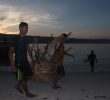Anita Morales, executive director of Metsa Foundation, said CARP should be implemented beyond 2008 because there are still a lot of lands that have not yet been taken over by the government and distributed to those who deserved them.
“There should be a political will to implement agrarian reform,” she said. “And the clamor should be land for the tillers, instead of land for the landless,” said Morales, whose group has been working with farm-based households employed in commercial agriculture sector.
Contrary to the figures given by the government, she said, more lands remain untouched by the government’s agrarian reform program.
“In Davao city’s third district, for instance, banana and pineapple plantations make up thousands of hectares which until now are still untouched by CARP,” she said.
Celso Pojas, spokesperson of the Kilusang Magbubukid ng Pilipinas in Southern Mindanao, also said that after 19 years of CARP, seven out of every 10 farmers are still landless while real CARP beneficiaries are constantly being threatened with land confiscation.
Pojas said that high amortization of lands under CARP and the meager rental payment by multinational companies renting lands from CARP beneficiaries often lead to cancellation of the beneficiaries’ Certificate of Land Ownership Award (CLOA). He also said that government oftentimes limited CARP to government lands, abandoned lands or those being offered voluntarily to sell and private lands below 50 hectares.
“They leave big landholdings of the Floirendo’s, Lagdameo’s, the Ayalas and the Dizons alone,” said Pojas.
Meanwhile, according to the National Statistics Office 2001 survey, of the 25 million children between the age of five and 17 nationwide, four million children are already working.
Of the four million working children, only 2.6 million were able to attend school. More than 50 percent of these children are in agriculture and 2.4 million of them are exposed to physical, biological and chemical hazards. In the largely agricultural region of Southern Mindanao, the number of child workers is estimated at 342,000.
“As long as this country remains poor, as long as this country is ‘not free,’ children cannot go to school and child labor will remain a festering sore,” said Ponciano Ligutom, regional director of the Department of Labor and Employment.
�Both the national and local government have a role to play to solve the problem,� he said. �We have to increase awareness of people to do something about this.” (Germelina A. Lacorte/davaotoday.com)
Land Reform, Poverty









